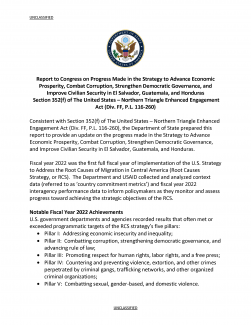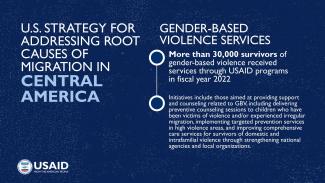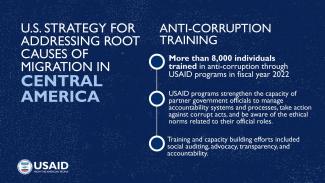The U.S. Strategy to Address the Root Causes of Migration in Central America, or Root Causes Strategy, directed by the President in Executive Order 14010, focuses on a coordinated, place-based approach to improve the underlying causes that push Central Americans to migrate, and that “take(s) into account, as appropriate, the views of bilateral, multilateral, and private sector partners, as well as civil society.”
This Strategy lays out a framework to use the policy, resources, and diplomacy of the United States, and to leverage the expertise and resources of a broad group of public and private stakeholders, to build hope for citizens in the region that the life they desire can be found at home.
Fiscal year 2022 was the first full fiscal year of implementation of the U.S. Strategy to Address the Root Causes of Migration in Central America (Root Causes Strategy, or RCS). USAID is just one of several U.S. Government agencies working towards the Strategy's Objectives. The Strategy is organized around five pillars, namely:
Pillar I: Addressing economic insecurity and inequality;
Pillar II: Combatting corruption, strengthening democratic governance, and advancing rule of law;
Pillar III: Promoting respect for human rights, labor rights, and a free press;
Pillar IV: Countering and preventing violence, extortion, and other crimes perpetrated by criminal gangs, trafficking networks, and other organized criminal organizations;
Pillar V: Combatting sexual, gender-based, and domestic violence
In FY 2022, USAID has achieved/seen progress in several areas:
- USAID support for nearly 8,000 private sector firms in northern Central America has helped create and sustain more than 90,000 jobs. Job creation provides a key path for economic opportunity, especially for youth who are likely to migrate or become involved in illegal activities.
- USAID programs trained nearly 12,000 individuals in workforce development. Technical training helped participants improve and certify skills needed to pursue new or improved employment; participants also learned how to start businesses, and received coaching and mentoring during the employment-seeking process.
- USAID-supported firms generated more than $320 million in sales. Increased productivity and production of small-holder farmers or firms helps reduce poverty, a key root cause of migration, through improved livelihoods and broad-based economic growth.
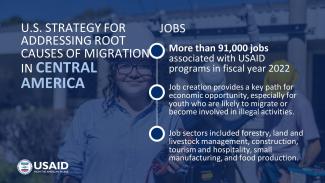
- USAID has leveraged roughly $189 million from both the public and private sectors (up from the previous year) to increase productivity and incomes for more than 60,000 agriculture industry producers participating in food security programs in Guatemala and Honduras.
- More than 59,000 individuals applied improved management practices or technologies to their agricultural land. Small producers received technical assistance and training in applying improved agricultural practices and technology to their plots. These actions increased the income of producers and improved livelihoods.
- More than 104,000 individuals were reached with USAID food security programming. According to the recent LAPOP 2022 national survey, mothers who experience food insecurity and have a negative outlook for the future are more likely to migrate irregularly.
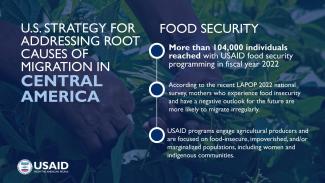
- USAID has reached more than 465,000 youth through support for primary and secondary education in areas of high out-migration in El Salvador, Guatemala, and Honduras.
- Nearly 175,000 children were reached with USAID nutrition interventions. Nutrition interventions among children under five remain essential to prevent and treat malnutrition and to improve child survival.
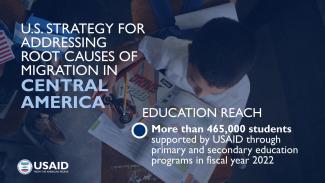
- USAID programs trained more than 1,500 justice sector personnel. Strengthening partner governments’ judicial systems is essential for transparency and accountability in democratic societies, as well as performance of those systems, measured by prosecutions and convictions.
- USAID programs trained more than 8,000 individuals in anti-corruption, strengthening the capacity of partner government officials to manage accountability systems and processes, take action against corrupt acts, and be aware of the ethical norms related to their official roles.
- USAID programs trained and supported more than 300 human rights defenders. Increasing the number of human rights defenders trained and supported through U.S. government assistance will result in increased capacity to report human rights violations and advocate for the protection of human rights. This leads to improved government accountability and transparency, as the public becomes more aware of government violations.
- More than 30,000 survivors of gender-based violence received services through USAID programs.
To learn more about the FY 2022 results under the Root Causes Strategy, read the U.S. Government's Report to Congress or visit this State Department webpage.
